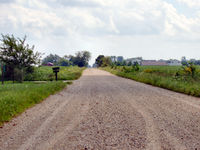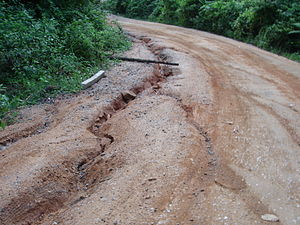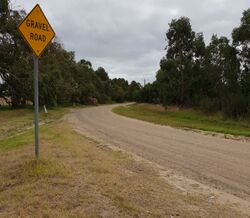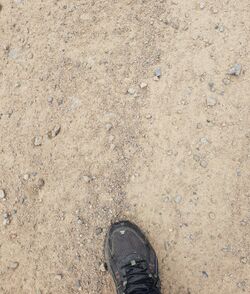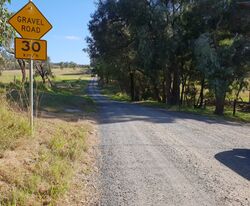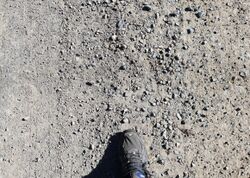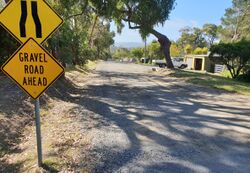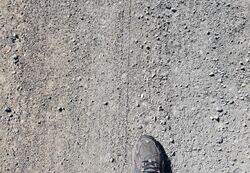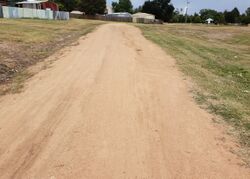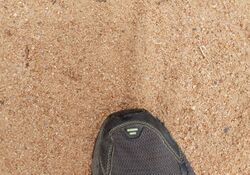Talk:Key:surface
Archives | |
|---|---|
| |
recycled plastic enviro path surface
Recycled plastics are being used for some paths e.g. National Park path over sand - What is the correct surface for these type so that these can be measured and identified easily?
Ewen Hill (talk) 12:55, 9 July 2019 (UTC)
- Recycled shredded polymers are widely used for equestrian arenas and ménages, amongst others, in the UK. Perhaps a tag of surface=fibre would cover these and any other similar materials?
- Here's a link to a page describing the types of fibre material commonly used, at least in the UK:-
- Recycled plastic fibre material.
- For the path example in the Mapillary image above perhaps surface=sett with material=plastic? --John Grubb (talk) 17:33, 21 July 2019 (UTC)
gravel / water-bound / macadam
The two images for "gravel" seem to show two different sorts of surface:
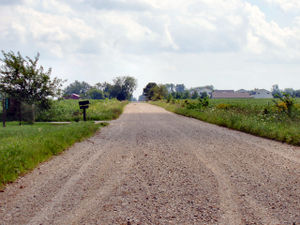
the lower one gravel clearly without sand

the upper one might be a mixture of sand and gravel, also called "water-bound macadam"
Should "gravel" also be used for "water-bound macadam"? Or should we divide them: gravel mixed with sand (macadam) from gravel without sand (less quality for bicycles)? --Mueck 21:47, 17 April 2009 (UTC)
- (I swapped your images: think their positions match your words now :)). Distinguishing compacted sand+gravel mixes from loose gravel would be really useful round here. What do you say to:
- Both forms can go by the name "water-bound macadam", if I'm reading wikipedia:Macadam, so we should perhaps not use that term (similarly, "tarmac", which can mean all sorts of things in everyday usage). For me, the important quality is compactedness vs. looseness rather than binding agents - two-wheelers tend to go sideways on the loose stuff, but compacted gravel surfaces can be quite nice. I've also left the existing surface=gravel in there for backwards-compatibility purposes. --achadwick 21:40, 23 April 2009 (UTC)
- Should we distinguish between deliberately-rolled surfaces that have been compacted with a roller and those that have had some compaction from passing vehicles? --achadwick 21:40, 23 April 2009 (UTC)
- Because of possible rendering of surface values the next days or weeks I hurried up a little bit ;-) and added compacted to english and german surface-page. It is shorter and more flexible, because not only gravel may compacted. Some of the pebblestone-images also look very compact ;-) To the last question: We should look (only can look ...) at the result, not the method ;-) I don't know, if we should divide between gravel an loose_gravel, too, if compacted exists? --Mueck 21:32, 24 May 2009 (UTC)
- *Every* way made of stone material will be compacted in time, either by a rolling machine or by regular usage. This isn't a criterium to be distinguished by a mapper. What he just *can* (and needs to) distinguish is whether a surface looks hard or soft, loose or firm. A macadam way/ waterbound surface (as invented by the Roman empire) has a firm surface, if well maintained. A gravel way has a loose surface, because it misses the binding (fine) components, although it may be compacted by masses of the traffic. As a consequence, a waterbound surface is good to walk, cycle, or ride on, whereas a gravel way bad to use, because the stones are loose. This is what needs to distinguish with stone material way, and this can be done easy and with relevance (as opposed to 'smoothness' what nearly every person sees different). 'Compacted' is unclear, 'gravel' and 'fine_gravel' quite clear. 'macadam' is more precise than 'fine_gravel' but very little known or common. So my vote is that gravel and fine_gravel are enough. You don't need more on common regular ways used by agricultural or forestry vehicles, except asphalt/concrete or dirt tracks. 'fine_gravel' just dont't mean that this way is made exclusively out of fine gravel components (this kind of way would be loose, don't last long, or endure heavy vehicles), just that fine_gravel is what can be seen on surface. A waterbound way made with a fine gravel surface is next to asphalt the best and most costly way, both in creating and maintenance, that's the reason why simple gravel ways can be seen more often in some areas -- Besides, the describing picture shows a way that lacks rolling and is just filled up, no way compacted. If this would have been done prior to the image, the passenger car wouldn't have created deep ruts like shown (Don't drive or ride on a waterbound way freshly made) --Taunide 18:54, 20 October 2011 (BST)
- fine_gravel is a part of waterbound, but waterbound is not only fine_gravel.
- "whereas a gravel way bad to use, because the stones are loose"
- fine_gravel might be loose, too, for al longer time, if it is not used like in a proces for building waterbound macadam ways ... --Mueck 22:43, 20 October 2011 (BST)
- Again, the pic here don't match your description what you want "compacted" should be, cause it's not showing a compacted surface, as could be seen in the tire ruts, period. If you want to promote "compacted" for this type of ways and be understand by other mappers you should start with a better picture and clearer description what's the difference to "gravel". --Taunide 10:47, 24 October 2011 (BST)
- Not compacted? The street on the image looks very plane. It wouldn't be such plane, if it is not compacted. If not compacted, the tire ruts would be deeper ... Depending of usage of a way, there may be also some loose material on it ...
- It might be, that your image is a better image for *compacted*...
- Changing the old image for *fine_gravel* showing loose material to your new image for a compacted way is no "evidence" for your single person theory that fine_gravel is compacted ... --Mueck 16:45, 25 October 2011 (BST)
- The old image didn't show a specific way, just a raw material, so the newer is better. Every way with a fine gravel surface needs to have a compound base structure, or it would not withstand pressure of heavy vehicles. I will not repeat myself here. We had the tag fine_gravel for more than a year without a definition and nobody seems to have a problem with it. Now I delivered a definition according to reality and tagging practice, what's the hell is your problem with it? --Taunide 09:21, 26 October 2011 (BST)
- And compacted is defined for 2.5 years including ways like this on the new image. That's the problem we have had in http://forum.openstreetmap.org/viewtopic.php?id=14098 with your single point of view ... And why should fine_gravel only be used for ways with heavy vehicles? And were is said, that loose gravel don't can have something stable beyond it? fine_gravel only defines the upper layer of a way like gravel, asphalt, sand, ... which all may have something beyond it, that we didn't see ... It's the upper layer, we only can map, and that's for your waterbound way NOT only fine_gravel. If the base layer of the way isn't stable enough for heavy vehicles, you will see it of deep tire ruts and can tag smoothness=bad or something like this, that's not a question of surface-key ... --Mueck 10:06, 26 October 2011 (BST)
- You contradict yourself. If "outer surface" is all we can see (and should be mapped with this attribute) then "compacted" is wrong because it can't be seen. The fact that people bring a picture to show a "compacted" way which shows imprints of a small motorcar which demonstrates this way misses compaction at all, because compaction is made by rollers, not by vehicles simply using the way. Then "fine_gravel" and "gravel" are perfect: that's what can be seen!
- Of course you can use "fine_gravel" for small park and garden ways alike too, but in the most common areas where ways like these showing up (and be mapped!): fields and forests you will see them with a firm underground, which in most cases can easily detected by most mappers as my pic shows. So that's the reason for this refreshed, typical picture.
- As said above, an additional attribute (smoothness) brings no help. Fine_gravel is clearly defined so it's quite easy to decide when to tag gravel or fine_gravel (it may be not so clear with "gravel" and "compacted" but that's the problem of that's definition...). In contrast, every mapper has a different understanding of what is "smooth", so this attribute is next to worthless. With thousands of mappers all is needed here are CLEAR definitions -- with no more attributes as indespensable for clear description of a certain map item!
- The problem with 'compacted' is, as stated above, that nearly all "gravel" ways are compacted too (at least if used by heavy vehicles), and therefore, mappers cannot decide what to tag. Keep on with it, if you like it, but keep fine_gravel too. Taggings will be much more impartial/objective.
- --Taunide 11:31, 27 October 2011 (BST)
- It's NO problem to see, if a way has only loose material or not.
- In the german forum I posted just another (german) example from another user for uncompacted fine_gravel ways. --Mueck 22:09, 27 October 2011 (BST)
- How to objectively distinguish between fine_gravel and compacted? The OSM-Wiki description is vague. According to Wikipedia macadam has a minimum stone size at the surface of 2cm and may be filled up with stone dust (water bound). Fine gravel is not allowed in a macadam road. In contrast a "fine_gravel" road has fine gravel on top and can be filled up with stone dust too. So the only difference between these two is the usage of fine gravel? Any objections adding this info to the OSM-Wiki?--Lukie80 (talk) 21:18, 2 May 2017 (UTC)
- fine_gravel implies not compacted, it is a loose covering, while compacted means a hard surface without or with few loose material--Dieterdreist (talk) 23:13, 2 May 2017 (UTC)
- How to objectively distinguish between fine_gravel and compacted? The OSM-Wiki description is vague. According to Wikipedia macadam has a minimum stone size at the surface of 2cm and may be filled up with stone dust (water bound). Fine gravel is not allowed in a macadam road. In contrast a "fine_gravel" road has fine gravel on top and can be filled up with stone dust too. So the only difference between these two is the usage of fine gravel? Any objections adding this info to the OSM-Wiki?--Lukie80 (talk) 21:18, 2 May 2017 (UTC)
- And compacted is defined for 2.5 years including ways like this on the new image. That's the problem we have had in http://forum.openstreetmap.org/viewtopic.php?id=14098 with your single point of view ... And why should fine_gravel only be used for ways with heavy vehicles? And were is said, that loose gravel don't can have something stable beyond it? fine_gravel only defines the upper layer of a way like gravel, asphalt, sand, ... which all may have something beyond it, that we didn't see ... It's the upper layer, we only can map, and that's for your waterbound way NOT only fine_gravel. If the base layer of the way isn't stable enough for heavy vehicles, you will see it of deep tire ruts and can tag smoothness=bad or something like this, that's not a question of surface-key ... --Mueck 10:06, 26 October 2011 (BST)
- The old image didn't show a specific way, just a raw material, so the newer is better. Every way with a fine gravel surface needs to have a compound base structure, or it would not withstand pressure of heavy vehicles. I will not repeat myself here. We had the tag fine_gravel for more than a year without a definition and nobody seems to have a problem with it. Now I delivered a definition according to reality and tagging practice, what's the hell is your problem with it? --Taunide 09:21, 26 October 2011 (BST)
- Again, the pic here don't match your description what you want "compacted" should be, cause it's not showing a compacted surface, as could be seen in the tire ruts, period. If you want to promote "compacted" for this type of ways and be understand by other mappers you should start with a better picture and clearer description what's the difference to "gravel". --Taunide 10:47, 24 October 2011 (BST)
surface:middle=*
Hi, I created a new tag for the middle of the way, for details see: User:John07/middle_tag Please leave some comments. John07
Cement vs. concrete
(moved from definition to discussion page) Why doesn't surface=cement exist? People generally think of a cement surface as being very smooth, good for tennis courts and skate parks, while concrete is very rough and good only for vehicles. (by unknown)
- In actuality, both surfaces are made of concrete! The former is cement mixed with fine sand, the latter is cement mixed with sand and gravel. surface=concrete applies to both. (by unknown2)
- the difference between cement and concrete is that concrete is cement plus filler. Whether the concrete is rough or not depends on the treatment of the surface and on the grain size of the filler ingredients. cement usually is deployed with filler, pure cement is usually not used (but the filler might be very fine). -- Dieterdreist 15:40, 15 July 2010 (UTC)
- There is also a tag
smoothness=*, no need to tag different concrete surfaces. --Scai 18:33, 16 July 2010 (UTC)- It makes a big difference which surface you have, they all sound different with a white cane, see OSM for the blind. Not only persons on wheels are interested in the surface. Lulu-Ann
- Though concrete implies that a type of filler is used, it doesn't imply what type filler is used, and therefor say nothing about the smoothness of the end product. Concrete using fine gravel as filler is almost as smooth as pure cement, and with a treated surface makes no difference, while a concrete using a coars gravel often can be rougher, even with treatment. Therefor these two should be treated the same as a surface tag, while another tag can be used to describe the smoothness (
smoothness=*is already in use) --Skippern 09:36, 20 July 2010 (UTC)
- Though concrete implies that a type of filler is used, it doesn't imply what type filler is used, and therefor say nothing about the smoothness of the end product. Concrete using fine gravel as filler is almost as smooth as pure cement, and with a treated surface makes no difference, while a concrete using a coars gravel often can be rougher, even with treatment. Therefor these two should be treated the same as a surface tag, while another tag can be used to describe the smoothness (
- It makes a big difference which surface you have, they all sound different with a white cane, see OSM for the blind. Not only persons on wheels are interested in the surface. Lulu-Ann
synthetic surface for sport pitch?
Some pitch use synthetic (not grass but synthetic for football) maybe this would be great to be added for football pitch to have surface=synthetic.--Yod4z 13:46, 12 September 2010 (BST)
fine_gravel
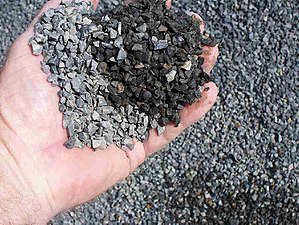
Any objections about using this image for fine_gravel? --Michi 21:58, 17 November 2010 (UTC)
- Have you ever tried to grab a "handfull of fine gravel" off a fine gravel way? This is just impossible because of it's compacted structure. "fine gravel" is just a surface. A fine gravel way consists of different types and sizes of stones. Just made out of fine gravel it wouldn't last long or endure heavy vehicles.
- A good picture would show a way paved with fine_gravel, like this one: [[1]] --Taunide 19:13, 20 October 2011 (BST)
- That's a nice image for "compacted". fine_gravel is only one part of waterbound macadam. Ways using fine_gravel only are sometimes found in gardening --Mueck 22:28, 20 October 2011 (BST)
::: I agree. "fine_gravel" should be loose like in gardens, in parks and in the mountains. "compacted" should be a compressed mixture of fine gravel and stone dust and is not loose at all.--Lukie80 (talk) 20:58, 24 April 2017 (UTC)--Lukie80 (talk) 20:49, 2 May 2017 (UTC)
Does anyone know, where "fine_gravel" is "created"? I only found, when it enters this page (18 Sep 2010 by Cmuelle8), but no discussion ... --Mueck 22:47, 20 October 2011 (BST)
- fine_gravel, gravel, pebblestone fractions are created in a gravel pit or a quarry. Sorting is carried out using stationary or mobile :machines. https://www.youtube.com/watch?v=RU3VXxXvwWE https://www.youtube.com/watch?v=18r3WUpwsXM
- --Cz ja 16:15, 27 January 2018 (BST)
surface=stones, surface=rock
Paths for non-motorised use (highway=footway, highway=path etc) should ideally always be tagged with surface. How can we tag the surface of paths full of either small or large rocks and stones. I would propose surface=stones.
Besides, I would also add surface=rock for rocky trails in the mountains, i.e. when the surface is a compact rock rather than many single rocks or stones. --solitone 16:50, 19 January 2012 (UTC)
surface:cycleway and surface:sidewalk
Cycleways tagged as cycleway=lane or cycleway=track often have different surfaces than that of the main road but currently such surfaces can't be tagged. I propose to introduce surface:cycleway=* to describe the surface of an associated cycleway that is not mapped as a separate way. Similar for an associated sidewalk=* where the surface could be tagged as surface:sidewalk=*. Any objections to add these tags to the main page? --polderrunner 21:38, 24 September 2012 (BST)
- Hi, it is possible to tag this:
cycleway:right:surface=*See TagWatch. You can replace the "right" with "left", "both" or without the middle subkey: cycleway:surface. (Note:footway:right:surface=*TagWatch is also more common thansurface:footway=*TagWatch)--MasiMaster 13:46, 25 September 2012 (BST)- Ok, I didn't know about those tags. I had only looked for surface:*-something and found nothing (except the few cases I have tagged). Normally I would expect the first part of the key to be the tag type followed by subkeys to define the scope of the tag. That is how it works for e.g. oneway:bicycle or maxspeed:hgv. Since the 'reverse' tagging style is already in use for surface I won't go further with my proposal even though I'm not happy about the syntax of these tags. BTW, why do most of these tags specify the side of the road, that seems a bit redundant? --polderrunner 16:42, 25 September 2012 (BST)
- Good question... Don't know why, but if on both sides is the same surface, you can use
cycleway:both:surface=*or simpliercycleway:surface=*. --MasiMaster 18:17, 25 September 2012 (BST)
- Good question... Don't know why, but if on both sides is the same surface, you can use
- Please consider documenting those tags somewhere in the wiki, not everybody uses taginfo to search for them. --Scai 07:56, 26 September 2012 (BST)
- I simply added this to Key:cycleway and DE:Key:cycleway. Feel free to edit or correct this. I plan also to add this to the Key:footway page. OK? --MasiMaster 15:40, 26 September 2012 (BST)
- Seems ok to me, thanks. --Scai 19:18, 26 September 2012 (BST)
- Would it be possible to also document these tags at
surface=*? Many mappers would start looking here and not atcycleway=*for such surface tags. And don't forget the sidewalks! --polderrunner 20:20, 26 September 2012 (BST)- Now I added this at
surface=*. In my point of view sidewalk can be a additionaly value for footway, like track/lane for cycleways. Syntax for sidewalks does not work (so I don't add this to footway & sidewalk):- cycleway:
highway=*+cycleway:right=track+cycleway:right:surface=asphalt. - footway/sidewalk:
highway=*+footway=sidewalk(without right/left??) +sidewalk:right:surface=asphalt - better:
highway=*+footway:right=sidewalk+footway:right:surface=asphalt
- cycleway:
- I think this part better belongs to the footway- or sidewalk-talkpage. --MasiMaster 15:26, 27 September 2012 (BST)
footway=sidewalkis always (should be) used on separately drawn ways withhighway=footway(or highway=cycleway, when cycling on sidewalk is allowed). "This is a footway + this footway is a sidewalk." Compare tosidewalk=left/right/both. Alv 18:50, 27 September 2012 (BST)- So what should be used for the surface of a sidewalk when it is marked as a property of the road (and not as a seperate pathway)? PinkShinyRose 17:07, 4 January 2013 (UTC)
- Now I added this at
- I simply added this to Key:cycleway and DE:Key:cycleway. Feel free to edit or correct this. I plan also to add this to the Key:footway page. OK? --MasiMaster 15:40, 26 September 2012 (BST)
- Ok, I didn't know about those tags. I had only looked for surface:*-something and found nothing (except the few cases I have tagged). Normally I would expect the first part of the key to be the tag type followed by subkeys to define the scope of the tag. That is how it works for e.g. oneway:bicycle or maxspeed:hgv. Since the 'reverse' tagging style is already in use for surface I won't go further with my proposal even though I'm not happy about the syntax of these tags. BTW, why do most of these tags specify the side of the road, that seems a bit redundant? --polderrunner 16:42, 25 September 2012 (BST)
Categories
How about grouping physical condition of highways?
Like this (sport and path surfaces will be in another section):
From left (general tag) to right (more detailed surface description)
I think it's more intuitive than now.
| General tag | Tag | Smoothness | Description |
surface=paved
|
asphalt
concrete metal (bridges etc.) wood (bridges etc.) |
excellent | perfect surface (roller blade, skate board and all below) |
| good | no bumps or potholes (racing bike and all below) | ||
| intermediate | some bumps (city bike, sport cars, wheel chair, Scooter and all below) | ||
| bad | damaged road (trekking bike, normal cars, Rickshaw and all below) | ||
| very_bad | heavily damaged road (off-road vehicles and all below) | ||
| horrible | close to impassable, huge potholes (ATV, tanks) | ||
| paving_stones
grass_paver sett cobblestone |
good | ||
| intermediate | |||
| bad | See above ^ | ||
| very_bad | |||
| horrible | |||
surface=unpaved
|
compacted | excellent | same as fine_gravel now |
| good | |||
| intermediate | |||
| bad | See above ^ | ||
| very_bad | |||
| horrible | |||
| gravel
(breakstone) | |||
| good | |||
| intermediate | |||
| bad | See above ^ | ||
| very_bad | |||
| horrible | |||
| grass
dirt ground salt sand snow ice |
Fairly smooth surface | ||
| See above ^ | |||
| See above ^ |
- Paving stones may have "excellent" smoothness and so on Mateusz Konieczny (talk) 17:48, 10 March 2020 (UTC)
Ground vs earth
Following from this discussion in the tagging mailing list, it seems that ground and earth may be essentially the same thing. Since earth is much less used, could we recommend against using it and recommend using ground instead? This simplifies application development, translations and teaching significantly.--Fernando Trebien (talk) 14:42, 13 March 2014 (UTC)
- +1 I'd rather have just one value, and ground seems the best choice.--solitone (talk) 15:22, 13 March 2014 (UTC)
- Yes, there is no point in two different values for the same. Bulwersator (talk) 08:47, 1 May 2014 (UTC)
- +1 I propose to change the wiki to deprecate the use of earth and dirt and use ground instead. --Viking81 (talk) 09:58, 8 April 2016 (UTC)
- Ground is more generic and includes for example cases like heavy admixture of natural gravel and loose stones in mountainous areas (that would not be
surface=earth- right? Mateusz Konieczny (talk) 06:58, 22 February 2023 (UTC) - Maybe this is just my two cents but I don't think "earth" and "dirt" are synonymous. In my view, "earth" is the surface that would remain after removing topsoil, if any. In the Mid-Atlantic area of the United States, I've seen "earth" mapped for rocky trails that are mostly dirt but there are also many immovable rocks. A semicolon separated tagging of surface=dirt;rock could suffice but it's not clear to me that many renderers/maps parse those well. I totally recognize that we have keys smoothness=* and tracktype=*, but wanted to call out a reason I've seen "earth" mapped. - Osmedit (talk) 22:28, 27 September 2025 (UTC)
cobblestone:flattened vs sett
The wiki seems to discourage this value, and suggests sett instead. Besides, cobblestone:flattened and sett have the same picture. To me, "cobblestone:flattened" describes a pretty different paving, as show in these pictures [2], [3]. By contrast, these are examples of what I would consider "sett" [4], [5]. Can we describe better these two values?
—Preceding unsigned comment added by Solitone (talk • contribs) 13h17min de 28 de abril de 2014 (TC-3)
- -1 Can't we use "stone" for that?
- Yeah it's confusing which tag we should all be using. The page here has grouped "setts" under surface=cobblestone. "Cobblestone paving. "Cobblestone" is used in the colloquial meaning and includes the type of stones that would more precisely be called "setts"." but then it also lists surface=cobblestone:flattened with no description.
- It's been that way since the big table of values was added this edit, and so since then it's never been very clear what "setts" should actually be mapped as. The problem is, many people including me would actually look at these "setts"/"flattened cobblestone" in real life, and we'd call them cobblestone, without making a fussy distinction. You only have to look at a google image search for 'cobblestone' to see that this word encompasses a variety, and mostly equates to setts/flattened cobbles these days.
- As a result the majority of surface=cobblestone instances in the database will probably be setts/flattened cobbles in reality. Maybe that doesn't matter, but I think the situation would clearer without the 'cobblestone:flattened' tag suggestion on here.
- Clearer would be 'cobblestone=flattened', an extra tag to allow anybody who worries about the distinction to make it.
- -- Harry Wood (talk) 10:34, 30 August 2014 (UTC)
Current scheme bears all the legacy of direct adopting of natural language terms, and it seems to be really bad. surface=sett or surface=cobblestone:flattened are obviously reflecting the same real life entity - roughly squared stones, which are sub-classes of more general surface=cobblestone. In the same time, there is no specific tag for natural shaped (rounded) cobblestone. Therefore, if we have something tagged with surface=cobblestone, it has two contradictory meanings: "any kind of stone" and "not flattened stone", which is inadequate. --BushmanK (talk) 19:35, 6 December 2014 (UTC)
paving_stones
The wiki says that paving stones are equally sized concrete stones, with a flat top [... and] a perfectly regular shape.
I reckon this value may also be used for natural stones with a similar shape, e.g. [6].
I would therefore remove the word concrete from the description. --solitone (talk) 09:12, 29 April 2014 (UTC)
- I think, it should be emphasized in the beginning, that paving stones are mechanically (by sawing or press-forming) perfectly shaped natural or artificial stones, intended to form regular pattern. They are not necessary equally sized, because there are paving patterns, utilizing more than one size of stones.
- Current description does not give clear way to distinct paving stones and sett stones (latter ones are just roughly shaped to be rectangular). --BushmanK (talk) 19:21, 6 December 2014 (UTC)
- Yes Solitone I agree with you. The current description seems to emphasise concrete a bit too much.
- Also the illustrations show very small stones (which I would be tempted to call "tiles") forming regular patterns. Reading "paving stones" I tend to imagine larger paving flagstones like this: File:Pavement in North London.jpg. In this photo these are actually concrete flagstones, but yes an even more typical "paving stone" would be made of ...stone. Also I wouldn't say they do need to be equally sized. Can be a haphazardly sized, but the difference with setts is that they're flatter and more precisely tessellated. Unless I'm missing a better tag for this photo (let me know) I'll change the description a bit, and use that photo in place of one of the smaller tile photos.
- -- Harry Wood (talk) 12:38, 18 January 2015 (UTC)
The way I understand it, mechanically perfectly shaped natural stone is tagged with sett.I've modified it.The RedBurn (talk) 09:29, 12 October 2016 (UTC)
maxspeed:practical
I propose to remove maxspeed:practical recommendation, this idea was clearly considered as bad - see Key:maxspeed:practical#Voting Bulwersator (talk) 06:42, 23 August 2014 (UTC)
- Not before there is a better alternative. A maxspeed:practical=15 on a desert dirt path is clearly 100 times more useful than any number of surface and tracktype attributes. RicoZ (talk) 09:04, 23 August 2014 (UTC)
- Are you sure that it is a good idea to recommend adding it everywhere? Bulwersator (talk) 09:30, 23 August 2014 (UTC)
- Everywhere where it is not realistic to guess a reasonable maxspeed from other attributes. There were already long discussions about tracktypes and some other of those attributes on the mailing lists, they are just as bad mess and subjective as maxspeed:practical. maxspeed:practical at least gives a numeric value which everyone can see and correct instead of second guessing what routing software might deduce from half a dozen of subjective attributes and country specific implicit assumptions.
- The maxspeed:practical proposal should be imho improved to allow specification of vehicle types and things like seasons (including rainy season etc).RicoZ (talk) 10:00, 23 August 2014 (UTC)
stepping stones?
How about surface=stepping_stones? The value already exists for fords and I have used it here - http://www.openstreetmap.org/way/300917046 but many times these ways are not through water so highway=footway+surface=stepping_stones would seem quite fitting. RicoZ (talk) 10:59, 30 August 2014 (UTC)
- I've used this, seems like a good idea. Has existing use https://taginfo.openstreetmap.org/search?q=surface%3Dstepping_stones. Here is an example https://www.flickr.com/photos/136319147@N08/49737347221/in/datetaken-public/, it's not crossing a river it's just to provide better footing at high tides. --Aharvey (talk) 13:11, 22 September 2020 (UTC)
Some language terms are country-specific
Ex: I have seen "macadam" used to describe both gravel and bitumen surfaces. In NZ a "metal" road is a gravel road. The gravel is also referred to as "road metal".
Because of this, use of these words needs to be avoided. --Beddhist (talk) 13:38, 25 August 2015 (UTC)
Children playground's surface
Hi all, tonight I went to a playground which I personally added to OSM, and noticed that the pavement wasn't made of concrete as I expected, but rather of that soft looking-like-tartan material (which allows children to softly land on the ground).
How could I map it? --Massic80 (talk) 22:07, 30 July 2017 (UTC)
- Uh, I just noticed Tag:leisure=playground: thanks for the advice! --Massic80 (talk) 14:51, 1 August 2017 (UTC)
Rough trail surfaces of natural stones


There are two kinds of surface for hiking paths I have always missed in the values (and can’t even tell if they belong to the paved or unpaved section).
First, trails in mountain regions are often secured against erosion by setting large natural stones found on the spot (size well above 20 cm). This makes a rough, steppy, hardly-driveable but very robust surface.
I started to tag them surface=stone which has been used more than 3,000 times according to taginfo, but now I think this value is too unspecific and might include pebblestones, cobblestones or sett as well. I suggest to tag them surface=natural_stones (the singular natural_stone might suggest a closed rock surface instead of single stones).
Second, how about stoneflagged trails? I’ve often met them in England on trails crossing boggy ground. I suppose they’re simply made of natural stones roughly split into plates. I suggest to tag them surface=flagstone.
--Kreuzschnabel (talk) 06:00, 13 August 2017 (UTC)
- "setting large natural stones" - I tag it as surface=cobblestone Mateusz Konieczny (talk) 21:08, 13 August 2017 (UTC)
Compacted vs dirt/gravel/etc.
Maybe we should state more clearly that the surface can only be considered compacted if it resists heavy rain and heavy loads (such as trucks). --Fernando Trebien (talk) 12:48, 27 December 2017 (UTC)
- I think it would be difficult to judge solely on visual inspection. But you are right, there is no visual difference between compacted and fine_gravel according to the Wiki. Only the durability, which is defined by lower layers, defines the difference between both. --Lukie80 (talk) 14:47, 15 January 2018 (UTC)
- In Brazil, many unpaved roads suffer erosion from heavy rain and poor maintenance. Some of them were built compacted but fall into disrepair. The result is the same as the following example in Thailand. There may be portions of the surface that become muddy when it rains and other that stay quite firm. This is the type of road that I believe should be mapped as
dirtinstead ofcompacted. - --Fernando Trebien (talk) 17:26, 6 December 2022 (UTC)
- @Fernando Trebien: - is surface of this road holding together? Is it earth which became muddy with wheels sinking into it when wet? Or is it eroding but in general holding together? Mateusz Konieczny (talk) 18:10, 6 December 2022 (UTC)
- They stay mostly firm with muddy patches. The situation is very variable for less important important roads. This is how they usually look when dry:

- This also looks a lot flatter than the examples on the wiki for
compactedandfine_gravel, which contributes to erosion, as water tends to pool in the middle instead of flowing to the sides. With the exception of a few well-maintained unpaved roads (which are the ones I think should be mapped ascompacted), grooves and holes are common and sometimes quite deep. They are almost always harmless if someone slows down and goes around them. They can be a problem with poor visibility at night or in fog. After heavy rains, the grooves and holes become muddy and there is no way of knowing their depth in advance. They look like this with more water-filled holes near the centerline of the road: 
- Some short problematic low stretches can stay like this for hours or days if they are near (often unmapped) wetlands:
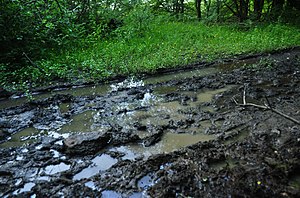
- In the absence of better images, here are some videos (please forgive the audio) that I think better illustrate the situation and the "feeling" of driving on them:
- Somewhat firm material without rain at night; it looks a lot like a
compactedroad - Somewhat firm material where fog and drizzle are common during the winter; it's basically the same type of road as the previous one, but under rain
- Average case days after heavy rain during the rainy season in Bahia, the weather there is usually dry though
- Somewhat loose material under rain
- Quagmires near the Amazon where it rains a lot most of the year, with a firm substrate but a loose top of variable depth; the firmest parts become slippery, the others become bogs
- Somewhat firm material without rain at night; it looks a lot like a
- --Fernando Trebien (talk) 16:47, 8 December 2022 (UTC)
- @Fernando Trebien: - is surface of this road holding together? Is it earth which became muddy with wheels sinking into it when wet? Or is it eroding but in general holding together? Mateusz Konieczny (talk) 18:10, 6 December 2022 (UTC)
Cobbles should be described as rounded for clarity
According to both cobble on Wikipedia and this British consultant. --Fernando Trebien (talk) 11:28, 15 January 2018 (UTC)
This forum post summarizes some wikifiddling here and puts it in light of the opinions of British mappers (native speakers) and German mappers (which look like would be those most affected by any changes in definitions). --Fernando Trebien (talk) 13:56, 22 January 2018 (UTC)
Pebblestones for foot massage
Some trails are made of stones for foot massage. Mention how to tag.
- http://www.eslinsider.com/blog/taiwanese-self-foot-massage-paths
- https://www.google.com.tw/search?q=taiwan+foot+massage+trails+path+stones&tbm=isch
Jidanni (talk) 14:21, 19 August 2018 (UTC)
- We have
surface=pebblestone@Jidanni: Mateusz Konieczny (talk) 20:27, 21 May 2024 (UTC)
Concrete:lanes
The description is confusing, especially with the accompanying photograph.
"Long, narrow concrete elements for a two-tracked vehicle (motorcars) so that the tires always hit the concrete. There might be sand, ground, grass, pavers, asphalt, etc. in between them. Note that if you tag a single-tracked way you just use concrete, since there are no lanes."
The photo shows a single track way with two concrete strips, one for left-hand wheels, one for right. Around my way (rural south-west UK) these are commonly used on agricultural land where the farmer needs a hard roadway for access but also needs to reduce costs on materials (and because they may not need as many planning hoops jumped through). As they are not intended for public use and thus not subject to heavy traffic the rough strip in the middle is not an issue. I would contend that this type of roadway can be described by this tag but that it is very much applicable to single-track "roads" as this is the most common usage. I can't recall ever having seen a two-lane road built in this manner. I would suggest that the description be revised for clarity/accuracy, especially given the accompanying example in the photo. Views...? --John Grubb (talk) 15:19, 6 September 2018 (UTC)
surface unpaved
I am located, and doing editing, in a very rural part of north Florida. Many of the counties here are minimally funded, and unable to provide proper road pavement for tertiary streets. Their default road surface is crushed lime rock, which is delivered by the truck load (as required) and then smoothed with a road grader. The surface can, under ideal conditions, harden to something approaching the original limestone. Under less than ideal conditions, it sometimes develops 'sand pools'. I am coding these rural tertiary roads as surface=unpaved, although I wish there were a better choice. surface=compacted does not appear to fill the bill, although the lime rock is compacted in a form. I am open to any suggestions that more appropriately indicates the surface, as unpaved is quite non-specific.
RayOnTheFarm (talk) 13:42, 9 April 2019 (UTC)
- Can you link some images of the situation? Based on description it sounds like
surface=compactedto me Mateusz Konieczny (talk) 18:05, 9 April 2019 (UTC- I concur -
surface=compactedseems to fit. Alternatively, as the limestone is crushed then perhapssurface=gravelwould be appropriate? --John Grubb (talk) 10:56, 11 April 2019 (UTC)- Based on images it clearly
surface=compacted. I created Tag:surface=compacted and added some detail about damage of compacted road Mateusz Konieczny (talk) 16:53, 12 April 2019 (UTC)- Having now also seen the photos I would agree that it is definitely
surface=compacted. --John Grubb (talk) 18:18, 12 April 2019 (UTC)
- Having now also seen the photos I would agree that it is definitely
- Based on images it clearly
- I concur -
I have the images, but for various reasons I am unable to get them to either upload to the wiki, nor to link in from Google Drive. Will work on it more tomorrow. --RayOnTheFarm (talk) 13:46, 10 April 2019 (UTC)
- Thanks for uploading images to https://commons.wikimedia.org/wiki/File:Road_surface_made_of_limerock,_Gilchrist_County,_Florida.jpg https://commons.wikimedia.org/wiki/File:Shoulder_details_of_a_limerock_road.jpg https://commons.wikimedia.org/wiki/File:Pothole_in_limerock_road_gilchrist_county_florida.jpg Mateusz Konieczny (talk) 16:49, 12 April 2019 (UTC)
Default values
I do not believe these changes are actually supported by the links to a thread in which only some participants expressed that opinion. Other responses, e.g. [7], do not seem support the "add surface to every single road" recommendation. If the wiki comments on the topic at all, it should reflect these differences in opinion. --Tordanik 12:43, 6 March 2020 (UTC)
- Do you think that https://wiki.openstreetmap.org/w/index.php?title=Key:surface&diff=1965980&oldid=1963153 is sufficient? Or maybe adding something about of minor value of surface=paved (especially on highway=motorway and other where it is obvious) or surface=unpaved (especially on tracktype=grade5 and other obvious cases)? Mateusz Konieczny (talk) 20:16, 6 March 2020 (UTC)
- @Tordanik: do you still think that this section should be changed? Mateusz Konieczny (talk) 07:07, 22 February 2023 (UTC)
Acrylic surface and DecoTurf value
DecoTurf is not a common name, but a brand name, and acrylic is also used in basketball courts and other sports grounds. So I think 'acrylic' should be used as the value. --Lepus (talk) 08:12, 9 June 2020 (UTC)
- Note that according to https://en.wikipedia.org/wiki/DecoTurf it is not just acrylic ("layers of acrylic resin, rubber, silica, and other materials on top of an asphalt or concrete base"). While a nonbrand name may be a good idea I am not sure is "acrylic" meaning clear. In general, note that tagging mailing list may be a better place to discuss this. Mateusz Konieczny (talk) 12:24, 9 June 2020 (UTC)
- Maybe you can refer to the description of other hardcourt brand, such as "GreenSet is a brand of acrylic hardcourt surface" and "Plexicushion is a brand of acrylic-based hardcourt tennis surface". Most hardcourt materials are acrylic based. And "hardcourt" seems to refer specifically to tennis courts, I'm not sure if it can be used elsewhere. --Lepus (talk) 05:26, 10 June 2020 (UTC)
How to map seashell-covered roads
In the Netherlands, small seashells are commonly used as a surface on footpaths and bicycle paths, in a way similar to fine gravel (initially loosely deposited, incrementally more compacted and fine-grained when traffic uses the road). For example, see here and here. In practice, I think these roads are oftend tagged as `fine_gravel`, but technically this does not conform to the description on this page, which is "A multilayer pavement with a stone or gravel basis and a topmost surface of firm, granular grit, basalt or quartz", but I would think shells are neither grit, nor basalt or quarts (though it seems that "Shell grit" is actually a term in use).
There are some roads tagged with `surface=shells`, which I suspect refer to this kind of road (this tag is almost exclusively used in the Netherlands it seems), but this is not documented here.
So, what is the recommended tagging for these roads? I suspect it is `fine_gravel`, then maybe the description could be adapted to make this explicit? If it is `shells`, then maybe that should be added to this page?
--Matthijskooijman (talk) 20:13, 4 August 2020 (UTC)
- I went ahead to document the current practice of using
surface=shells, and mentioning thatsurface=fine_gravelis also used. --Matthijskooijman (talk) 13:16, 5 August 2023 (UTC)
Colored pavement
See Talk:Rendering of road surface in standard OSM style#Colored pavers for thoughts about when a trail is actually red, blue, etc. Jidanni (talk) 05:13, 4 February 2021 (UTC)
- Discussing tagging on page of specific renderer is not a good idea Mateusz Konieczny (talk) 07:08, 22 February 2023 (UTC)
Australian 'gravel road'
An Australian 'gravel road' typically contains a range of particle sizes ranging from clay to 20mm screenings. This range of particle sizes compacts to a firm road and might be maintained by annual grading. It is less commonly called a 'dirt road'.
Below is a surface that may match the current description of surface=fine_gravel. I would descibe it as grit, the tourist authority call it granitic sand, it is not sand , it includes a range of particle sizes and compacts to a semi durable surface. The photo is of a bike trail, the Great Victorian Rail Trail Yea, Australia.
Tonyf1 (talk) 07:27, 5 March 2021 (UTC)
- @Tonyf1: The first three seems to match
surface=compactedMateusz Konieczny (talk) 08:50, 5 March 2021 (UTC)
Stone slabs / stone blocks
Hi! I'm looking for a surface=* value for stone slabs or blocks. Many steps are made of stone slabs or stone blocks and there are also footpaths made of stone slabs, such as in parks.
-
Steps made of stone blocks
-
Steps made of stone slabs
-
Footpath made of stone slabs
There are a few uses of surface=stone:plates (71) and surface=stone_plates (51), but that doesn't quite fit for stone blocks, although it doesn't make a difference in terms of the surface. Any opinions or ideas? --Dafadllyn (talk) 18:20, 9 March 2021 (UTC)
- First and third looks like
surface=paving_stonesand I tagged them this way. Second I would mark assurface=settMateusz Konieczny (talk) 18:43, 9 March 2021 (UTC)

- Thanks for your reply! Setts are much smaller stone blocks than the stone slabs (or stone blocks) used for steps. Aren't paving stones smaller too (see the examples for
surface=paving_stones)? The slabs and blocks i have in mind are much larger, similar tosurface=concrete:plates, but made of (natural) stone. --Dafadllyn (talk) 19:49, 9 March 2021 (UTC)- I agree that typical ones are smaller but I would not consider size here as defining part. And this pieces, are still much much smaller than typical (at least in my region)
surface=concrete:platesMateusz Konieczny (talk) 23:56, 9 March 2021 (UTC)
- I agree that typical ones are smaller but I would not consider size here as defining part. And this pieces, are still much much smaller than typical (at least in my region)
- Thanks for your reply! Setts are much smaller stone blocks than the stone slabs (or stone blocks) used for steps. Aren't paving stones smaller too (see the examples for
- Actually, the definition of
surface=paving_stonesis a bit unfortunate anyway, because setts, cobblestones and grass pavers are usually also counted as paving stones. I'm still not completely convinced to map stone slabs and especially stone blocks as surface=paving_stones. Maybe some data consumers (e.g. cyclists or blind people) were interested in the difference between small artificial stones and bigger natural stone slates or blocks? Some other opinions? --Dafadllyn (talk) 20:28, 10 March 2021 (UTC)
- Actually, the definition of
- I've been encountering this issue on a university campus (and nearby neighborhoods all use marble slabs for house steps...), and I've simply tagged them
surface=stone. There are currently ~7700 uses (0.02%) worldwide. I agree thatsurface=paving_stonesdoesn't feel right. pkoby (talk) 12:43, 13 October 2021 (UTC)
- I've been encountering this issue on a university campus (and nearby neighborhoods all use marble slabs for house steps...), and I've simply tagged them
In Talk:Tag:highway=steps#incline=no we see steps that go neither up nor down... Jidanni (talk) 03:48, 31 January 2023 (UTC)
Definition of surface=dirt
The definition of surface=dirt is quite contradictory: the definition of earth, which seems to mean earth/soil, says that it is a duplicate of dirt. However, dirt is said to be "very similar" to ground, which can mean grass, clay, sand, earth, gravel or pebblestone. What does surface=dirt really describe? --Dafadllyn (talk) 19:46, 7 April 2021 (UTC)
- @Dafadllyn: maybe someone meant that earth/soil is quite similar to ground in general? (or used a different meaning of "dirt" but not sure is it viable to have a different meaning for it) Mateusz Konieczny (talk) 16:31, 3 June 2021 (UTC)
surface=dirt+surface=earth+surface=groundfor linking Mateusz Konieczny (talk) 07:03, 22 February 2023 (UTC)
Loose stone chippings
Some paths and areas in parks are made of loose stone chippings. Unlike surface=fine_gravel, bicycles do leave imprints or, if the layer of stone chippings is thick, get stuck. How to tag this surface? surface=stone_chippings? --Dafadllyn (talk) 20:11, 7 April 2021 (UTC)
- @Dafadllyn: I have seen used and used
surface=gravelfor that (which has hopelessly wide meaning) Mateusz Konieczny (talk) 16:32, 3 June 2021 (UTC)- @Mateusz Konieczny: Thanks, but i'd like to be more specific. --Dafadllyn (talk) 18:51, 8 June 2021 (UTC)
- @Dafadllyn: Then you may want to invent a new tag (
gravel=loose_gravel? ) Mateusz Konieczny (talk) 20:24, 21 May 2024 (UTC)- @Mateusz Konieczny:
surface=loose_fine_gravelwould seem clearer to me. --Dafadllyn (talk) 20:31, 18 September 2024 (UTC)
- @Mateusz Konieczny:
- @Dafadllyn: Then you may want to invent a new tag (
- @Mateusz Konieczny: Thanks, but i'd like to be more specific. --Dafadllyn (talk) 18:51, 8 June 2021 (UTC)
fibre-reinforced polymer composite grate surfaces
I'm using fibre_reinforced_polymer_grate for the fibre-reinforced polymer composite grate surfaces eg https://www.wagner.com.au/media/1314 or https://gratingfrpaustralia.com.au/frp-grating-jibbon-head-boardwalk/ common on walking paths. Not to be confused with a metal grate which looks similar but but different material. These surfaces usually have a rough coating on the top for traction (compared to a metal grate which is more slippery when wet), but has holes to allow water to pass through. --Aharvey (talk) 08:08, 18 April 2021 (UTC)
- https://www.wagner.com.au/media/1314 is not loading @Aharvey: Mateusz Konieczny (talk) 16:33, 3 June 2021 (UTC)
- Maybe you can use
surface=fibre_reinforced_plastic:gratedirectly (instead of "polymer") and followingsurface=concrete:*? Though the holes and permeability part could possibly be separately tagged.
- ---- Kovposch (talk) 02:52, 4 June 2021 (UTC)
- https://www.openstreetmap.org/note/2641147 has some better pictures. --Aharvey (talk) 11:25, 30 June 2021 (UTC)
- Any reason for plastic over polymer, seems most references I found use polymer. Though I like the idea of `:grate` so maybe
surface=fibre_reinforced_polymer:grate? --Aharvey (talk) 11:29, 30 June 2021 (UTC)
- Scientifically, "Plastic" and "polymers" have specific meanings. It's possible they are used interchangeably and wrongly in engineering. I want to avoid that discussion. "Plastic" is a more common everyday word. It's widely used in
material=*andsurface=*. "Polymer" is only used for this here. - I know the norm is underscore, but should hyphenated "fibre-reinforced" be used instead of underscore (replacing whitespace)?
- ---- Kovposch (talk) 11:20, 27 July 2021 (UTC)
- It does seem the polymer and plastic terms are used interchangeably for this kind of surface material. However after doing more tagging I find the full term cumbersome, simply
surface=frp_gratingorsurface=frp:gratewould be much easier to tag, and based on a google search it's pretty clear what it refers to. --Aharvey (talk) 01:10, 3 August 2021 (UTC)- A clever trick to avoid choosing between 2 words, though don't know how acceptable abbreviations are . ---- Kovposch (talk) 12:11, 9 August 2021 (UTC)
- Wait, this doesn't work. There's fiberglass-reinforced plastic using the same "FRP", together with GRP and GFRP for glass (fiber) reinforced plastic. Although carbon fiber reinforced plastic uses "CRP" or "CFRP", it is still a kind of fiber-reinforced plastic. ---- Kovposch (talk) 12:29, 9 August 2021 (UTC)
- "FGRP" is not as common as "FRP" in the fiberglass-reinforced plastic usage. ---- Kovposch (talk) 12:44, 9 August 2021 (UTC)
- It does seem the polymer and plastic terms are used interchangeably for this kind of surface material. However after doing more tagging I find the full term cumbersome, simply
- Scientifically, "Plastic" and "polymers" have specific meanings. It's possible they are used interchangeably and wrongly in engineering. I want to avoid that discussion. "Plastic" is a more common everyday word. It's widely used in
Image sample:
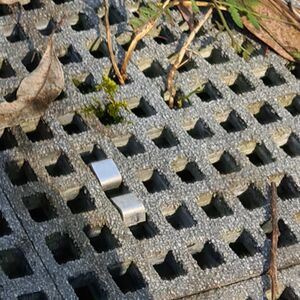 --Aharvey (talk) 00:15, 18 July 2022 (UTC)
--Aharvey (talk) 00:15, 18 July 2022 (UTC)
Relatedly, I noticed there's a surface=metal_grid (1265 instances) in Key:surface#Values, despite Talk:Key:surface#Steel grid bridges suggesting surface=metal_grate (38 instances). Wonder how the "grid" vs "grate" difference comes into play.
-- Kovposch (talk) 17:57, 9 August 2021 (UTC)
New paving, not seen before
I've recently done an update survey of a major housing development in my locality and have surveyed a parcel developed by a non-mainstream developer. Unlike the other "big" developers with parcels in the development who have opted for asphalt or block paving for their resident's parking bays and complimentary design for their building:cladding= this developer has gone "freelance" and used a system similar to surface=grass_paver but which isn't for their parking bays, although going with a theme for building:claddng= similar to the neighbouring developers (probably due to planning stipulations). The wearing surface in their parking bays consists of a honeycomb of hexagonal cells, probably polymer-based, filled with fine gravel. Looking at the list for the surface= page there is nothing close to it.
Does anyone know what this is called, formally? I've gone for surface=gravel_grid for now. Would surface=grass_paver adequately describe it (suspect not, due to the absence of grass - yet!). surface=gravel...?
Also, I can post a photo if someone can tell me how to do it!
Meanwhile, this is identical - albeit square-section cell:- https://www.ibran.co.uk/products/gravel-parking-grids
Guidance appreciated. --John Grubb (talk) 20:48, 28 October 2021 (UTC)
- Yeah things are getting complicated. Recently there's already an argument in https://www.reddit.com/r/openstreetmap/comments/p1rr0z/what_surface_tag_should_i_use_for_this_path/ on whether only stones are
surface=grass_paver, not including metal grids. Talk:Key:surface#fibre-reinforced_polymer_composite_grate_surfaces above is another demonstration.surface=*is in need of detailing, starting fromsurface=concrete:lanesandsurface=concrete:plates. Only formal one out there is Proposed_features/Paving_stone_details forpaving_stones=:*only. - I'm afraid
surface=gravel_gridwill be misunderstood as the opposite, using gravel as the "grid" structure to hold grass or soil together. There are 4surface=gravel_paverinstances in the logic of your inspiration.
- New users need to use Wikimedia_Commons#Embedding_media_on_this_wiki to post images.
- ---- 04:33, 29 October 2021 (UTC)
- This is the exact system:- https://www.abg-geosynthetics.com/products/sudsgrid-40-permeable-pavers.html Hmmm - surface=permeable_paver...?? --John Grubb (talk) 18:18, 29 October 2021 (UTC)
- For the time being, running with surface=permeable_paver, permeable_paver:fill=gravel until there's a concensus and a schema settled on. The combination seems to offer a bit of scope for "future proofing" as permeable_paver:material=plastic/metal/concrete/etc. and permeable_paver:shape=hexagon/round/square/etc. options present themselves to describe the cell-structure construction. There is the potential to conflict with/supersede surface=grass_paver as this idea could easily replace it (surface=permeable_paver, permeable_paver:fill=grass, permeable_paver:material=concrete) - although the fill would actually be soil in practical reality... --John Grubb (talk) 18:53, 30 October 2021 (UTC)
- This is the exact system:- https://www.abg-geosynthetics.com/products/sudsgrid-40-permeable-pavers.html Hmmm - surface=permeable_paver...?? --John Grubb (talk) 18:18, 29 October 2021 (UTC)
ground - dirt - earth (soil)
I see that this is popping up every few years and nobody actually touches the descriptions. I have a problem with these attributes: they are messy, the usage contrdicts the wiki and the wiki contradicts itself, too. Also there seems to be problem with language (I am not sure even it's English usage, also isn't quite working on others).
- ground: usage 5.94%; dictionary say "the solid surface of earth", "surface of a planet", "soil", "soil or rock". To me it seems that is exactly what a path has when people just start walking there, on a field, in a forest, etc. It is same as soil, when dry it is dirt, when wet is is probably mud. (There are "rock", "mud" [for permanently wet ground], "clay", etc. for more specifics.)
- dirt: usage 2.49%; dictionary say "a substance, such as mud or dust, that soils something", "filthy or soiling substance" or "not clean", "loose or packed soil or sand", "earth on ground, especially when it's dusty". This seems to me a pretty bad attribute for a surface: sounds like there is an underlying surface (ground) and filth (dirt/dust) on it. Maybe there are areas with permanent fine dust on them and these are real whole dirt surfaces, but generally I do not see that this would describe the surface better than "ground".
- earth: usage: 0.31%; dictionary say "the planet earth" (that is the majority of 1st meaning everywhere); "the substance of the land surface, soil", [interestingly, Merriam-Webster shows a lot of meanings I'm very unfamiliar with], "areas of land distinguished from sea and air", "surface substance of the planet Earth". Usage probably reflects the aversity to this attribute, as its main meaning seem to be the planet, and other meanings seem to mean basically anything from the category of "unpaved".
- soil: usage: 0.02%, just mentioning since it seems to mean or implied by all the above. It's not recommended, and I second that.
I propose to disprefer earth as it's both low usage, very nonspecific and sounds weird (for foreign speakers? It's like "surface=planet"). I also propose to prefer ground to dirt (using on natural soil surfaces) since it is not obvious how something is "dirt" which is not "ground" or "sand", also dirt implies dry material (which is only true half of the time); I suggest to use "dirt" on specifically fine dust/dirt surfaces, my immediate example could be an area with smut/soot/grime, or an attic with 50 years of dust.
So generally I propose surface=ground as the main attribute for this default (soil/earth/ground/dust) surface (which matches usage as well). -- grin ✎ 08:07, 3 November 2021 (UTC)
- Thanks for tackling this!
surface=groundseems to be far less specific - and would include for example forest path covered with needles/leaves/rocks/roots/beaten earth/mix of that.surface=dirt/surface=earth/surface=soilseems to be synonymous and mean roughly "loose or packed soil or sand" Mateusz Konieczny (talk) 11:50, 3 November 2021 (UTC)- There are other attributes which are fine by me, including most of what you mentioned (needles, rocks, roots). I usually use
surface=groundwhere there isn't a more specific attribute (and I exclude dirt, earth and soil here, which is exactly my point here :-)). --grin ✎ 12:17, 3 November 2021 (UTC)
- There are other attributes which are fine by me, including most of what you mentioned (needles, rocks, roots). I usually use
- "I propose to disprefer earth as it's both low usage, very nonspecific and sounds weird (for foreign speakers? It's like "surface=planet"). " - heh, for me
surface=dirtseems weird and less specific Mateusz Konieczny (talk) 11:50, 3 November 2021 (UTC)- For me "earth" means a planet, then land, then a few other things and maybe after those does it mean "soil", that's why it feels weird. "Dirt" feels also bad since it seems to be analogue to "filth", which is not really a scientific way to approach surfaces. :-) (For me dirt is something on an asphalt surface, for example, not anything would make up a road surface, but it may be my deficiency in English language.) --grin ✎ 12:17, 3 November 2021 (UTC)
- "Dirt" and "earth" are both synonyms of "soil", but can also have other meanings. Like Mateusz, i also use the less specific "ground" if the surface is mixed (e.g. soil with roots and stones or rock). --Dafadllyn (talk) 19:05, 10 November 2021 (UTC)
- @Dafadllyn: According to multiple dictionaries "dirt" has the primary meaning of "filth[y]" (originated from the word "excretum" aka. shit), or filth covering the surface of something (so it is not the surface, it is the filth on it), and secondary or tertiary meaning is "soil or sand" (also marked "U.S. usage" in a few books); "earth" has (in some dictionaries at least) "land surface, soil" as primary meaning but it has a lot of other connotative meaning varying wildly (apart from the planet of that name) which feels wrong to me. The primary meaning of "ground" is "surface of earth [or another planet]" or "soil" in every dictionary I have checked. But I guess this question shall be decided by our aboriginal Englishmen. ;-) --grin ✎ 08:46, 18 July 2022 (UTC)
- "Dirt" and "earth" are both synonyms of "soil", but can also have other meanings. Like Mateusz, i also use the less specific "ground" if the surface is mixed (e.g. soil with roots and stones or rock). --Dafadllyn (talk) 19:05, 10 November 2021 (UTC)
- @Grin: I'm not a native English speaker either (you likely find one on the "tagging" mailing list), but as far as i know and according to dictionaries, ground as a surface means "the solid surface of the earth" and soil means "the upper layer of earth in which plants grow, a black or dark brown material typically consisting of a mixture of organic remains, clay, and rock particles" (Oxford Dictionary). Hence, bare rock or stones are a type of ground, but aren't soil. Apart from the planet we live on and a den, earth can mean land or soil; so as a road or path surface it should be clear what is meant (albeit soil seems clearer). And finally, dirt is the less clear, as it can mean both soil or an unclean substance. Therefore, to be as clear as possible, it is probably best to use
surface=soilfor soil andsurface=groundfor ground that is mixed (not exclusively soil, e.g. soil with some bare rock, stones or roots) or changes often. --Dafadllyn (talk) 15:56, 18 July 2022 (UTC)
- @Grin: I'm not a native English speaker either (you likely find one on the "tagging" mailing list), but as far as i know and according to dictionaries, ground as a surface means "the solid surface of the earth" and soil means "the upper layer of earth in which plants grow, a black or dark brown material typically consisting of a mixture of organic remains, clay, and rock particles" (Oxford Dictionary). Hence, bare rock or stones are a type of ground, but aren't soil. Apart from the planet we live on and a den, earth can mean land or soil; so as a road or path surface it should be clear what is meant (albeit soil seems clearer). And finally, dirt is the less clear, as it can mean both soil or an unclean substance. Therefore, to be as clear as possible, it is probably best to use
- I apply
surface=dirtas per Dirt road on Wikipedia, withsurface=compactedbeing a special type of "dirt road" (per the common usage of the term in North America) with a higher standard of construction and maintenance. This seems to be in line with the use of this data by most consumers. I live in a rainy area in Brazil, so I expect the "compacted" roads to at least withstand the rain without getting too potted or too muddy; so, according to that Wikipedia article, I usesurface=dirthere for unpaved roads that would be called "dry-weather roads" in Australia, New Zealand and Finland. In dry climates, these roads would likely be much dustier (and therefore dirtier) than compacted ones. Most of what is mapped assurface=groundprobably consists of dirt roads according to the Wikipedia article. To avoid confusion, I never usesurface=earthnorsurface=ground. --Fernando Trebien (talk) 14:38, 20 February 2023 (UTC)- In general please do not try directly apply Wikipedia definition of words to OSM tags, it does not always work well. As long as you use
surface=compactedforsurface=compactedsurfaces andsurface=gravel/surface=fine_graveletc where they match and usesurface=dirtonly for actually earthen roads it will work fine. But please do not applysurface=dirtto road with rolled gravel just because it would be in some categorisation called "dirt road". Mateusz Konieczny (talk) 07:05, 22 February 2023 (UTC)As an American English speaker, I’m familiar with “dirt road” as an informal synonym for “unpaved road”. Just as a “tarmac” usually isn’t surfaced in tarmacadam, a “dirt road” isn’t necessarily surfaced in dirt. We just call an unpaved road by this term to contrast it with a paved road. But if someone tells you they’re driving on dirt, they definitely don’t mean gravel and probably don’t mean sand either.
This is just an idiosyncrasy of the English language, not a broader problem with trusting Wikipedia. The Wikipedia article actually does a pretty good job of describing this idiosyncrasy.
– Minh Nguyễn 💬 17:17, 22 February 2023 (UTC)
- In general please do not try directly apply Wikipedia definition of words to OSM tags, it does not always work well. As long as you use
- In English, each of these words is conventionally applied to different things. A road or an empty lot may be covered in dirt, but a dam made of the same substance is made of earth and called an earthen dam. If you stand on it, you’re standing on the ground. In a garden, the gardener adds soil to the ground to help the plants grow. Or they may add gravel instead for a xeriscaped garden, still growing out of the ground. – Minh Nguyễn 💬 17:28, 22 February 2023 (UTC)
image concrete:plates

Does the picture actually show concrete:plates or simply an old concrete track? These "plates" seems not to be laid! --Langläufer (talk) 14:35, 18 September 2022 (UTC)
- Good question. I just found it and it has not a great quality so it is hard to say Mateusz Konieczny (talk) 16:07, 18 September 2022 (UTC)
- I mean plates may form over time and it is often called concrete plates, but how should it be handled in osm? --Langläufer (talk) 16:31, 18 September 2022 (UTC)
image surface:fine_gravel
This picture is used on Tag:surface=compacted as an example with the description
"State of the art centreline crowned water bound surface=compacted forest track with drainage ditches"
It can't be both if fine_gravel isn't the same as compacted. For me, this description is correct and there is the need for a better example picture of a fine_gravel surface.
- @Vincentius: - see https://community.openstreetmap.org/t/surface-fine-gravel-is-it-for-loose-gravel-or-duplicate-of-surface-compacted/7533 - currently it mostly waits for someone to do edits on Wiki (I think so at least) Mateusz Konieczny (talk) 02:52, 3 March 2023 (UTC)
Is it also surface=grass_paver ?
question is at https://wiki.openstreetmap.org/wiki/Talk:Tag:surface%3Dgrass_paver Mateusz Konieczny (talk) 16:06, 14 March 2023 (UTC)
Linoleum and other rare values
Should we also mention somehow rare values such as https://wiki.openstreetmap.org/wiki/Tag:surface%3Dlinoleum ? Mateusz Konieczny (talk) 15:36, 20 March 2023 (UTC)
Are double values allowed?
Are double values allowed, such as ground;grass? If not, what instead? maro21 18:01, 2 June 2023 (UTC)
- I would avoid them if at all possible (for example
highway=trackwhich is 90% dirt with some grass or dirt tracks with grass between would be better tagged assurface=dirt, for combined cycleway/footwaycycleway:surface=*footway:surface=*are useful (andsurface=pavedwould be a good idea if one has paving stones and anther asphalt) Mateusz Konieczny (talk) 08:21, 7 June 2023 (UTC)
A sidewalk made of large prefab concrete stones
What value should this have? Images: 1 2 3 4 5. 'concrete' doesn't feel right because it's prefab stones, not a huge mass that's cast in place. 'concrete:plates' seems too industrial and ugly to be a good fit. 'paving_stones' looks like it's meant for much smaller stones.
- This is just concrete - made on site - with a little embellishment.. --Langläufer (talk) 17:43, 4 July 2023 (UTC)
- It could be unclear. There are questions on what
surface=concrete:platesshould include. --- Kovposch (talk) 05:45, 5 July 2023 (UTC)- Concrete plates are large laid heavy plates. It is also used for old roadways, when the concrete track has broken up and the resulting plates now tilt independently of each other. Every concrete track has expansion joints. --Langläufer (talk) 06:10, 5 July 2023 (UTC)
Path in streambed
A path doubles as a streambed. Your feet will stay dry in the dry season.
So we make the stream, mark it as intermittent. Then make the path along the same nodes, and use highway=path surface=streambed. I suppose. Jidanni (talk) 20:01, 17 September 2023 (UTC)
- That's what I would do too, however I would add a surface tag that actually describes the material of the path surface (
surface=gravelfor instance). If it's only a short section, and the path crosses the stream, you could addford=yes--rhhs (talk) 08:58, 19 September 2023 (UTC)
Improve layout of value table
Hi, I'd like to improve the layout of the Values table:
- Remove the Key column. The only key is surface.
- Remove the Element column. Usage should be described in a separate How to map section.
- Add a new Count column containing the taginfo count.
Any objections to these changes? -- Martianfreeloader (talk) 15:01, 7 January 2024 (UTC)
- I would not add taginfo counts, this does not add much and takes space Mateusz Konieczny (talk) 17:23, 7 January 2024 (UTC)
Tagging multiple surfaces
I've encountered a few instances where a path/trail should be tagged as one distinct way but is composed of multiple parallel surfaces. The wiki page presently lacks guidance for tagging in these situations and I'd my hope is (a) the wiki can be updated to reflect best practices and (b) I can learn how to tag these paths.
Three specific examples include: (1) Bloomingdale trail in Chicago (https://en.wikipedia.org/wiki/Bloomingdale_Trail & https://www.openstreetmap.org/relation/3419375). This trail is a concrete bike/footway with running track surface flanking the concrete on both sides. Runners desiring routes on soft surfaces could miss this path currently tagged as surface=paved and surface=concrete. I see arguments in favor of tagging schemes (i) surface=mondotrack;concrete (or tartan) (ii) surface=montotrack;concrete;mondotrack to distinguish that both sides have the rubberized surface for pedestrians (iii) surface=concrete and shoulder:surface=mondotrack (although this seems least accurate since the track surface is still clearly part of the trail).
(2) Burlington Greenway in Vermont (https://www.openstreetmap.org/relation/14781095#map=12/44.4882/-73.2440) pretty much identical to Bloomingdale trail in Chicago except the surface alongside the asphalt trail is fine_gravel on either side. Right now tagging of surface=asphalt is lacking fidelity because of the crushed gravel on both sides.
(3) Doho Park (36.059882630399784, 140.12468521270077) which is somewhat similar to the first case but the path is a combination of asphalt and tartan track
and (4) *:lanes (e.g., concrete:lanes and paving_stones:lanes) - the current guidance on this feels ambiguous because there is no obvious method to for tagging the center surface which could be dirt, grass, gravel, or a variety of other surfaces. Use cases where this would be important include running/cycling where an individual desires to train on certain surfaces or could be forced into the middle between lanes during competition.
If you have guidance on tagging these and other similar cases please share, and ideally, please help in updating the wiki to minimize ambiguity for myself and other mappers. Thanks! Osmedit (talk) 21:03, 14 October 2024 (UTC)
- Key:footway:surface , Key:cycleway:surface
- Personally,
surface:lanes=*is clearer on the layout. You have to make some assumptions on the meaning ofcycleway:surface=concrete+footway:both:surface=tartanlayout. In the simple case of 1 side only, it isn't nice to specify which side is which.
—— Kovposch (talk) 07:59, 15 October 2024 (UTC)
- In Northern Germany historic highways often have a 2-lane-pattern with different surfaces ("Sommerweg"): one lane is paved with cobblestone, the other is unpaved (usually sand). Depending on the weather conditions people used the appropriate lane. This could be tagged as
surface=cobblestone;sand, if multiple values were legal. --GerdHH (talk) 13:27, 24 February 2025 (UTC)
- In Northern Germany historic highways often have a 2-lane-pattern with different surfaces ("Sommerweg"): one lane is paved with cobblestone, the other is unpaved (usually sand). Depending on the weather conditions people used the appropriate lane. This could be tagged as
surface of railways
At this point I would like to start a discussion about whether surface=* can also be used in combination with railway=*.
The description of surface says just that it is useful in combination with highway=*. In fact, there are common ways that have both keys highway=* and railway=* in one path, especially with railway=tram. This also makes sense since in reality the lanes of cars are shared with those of trams (or industrial railways that go over the road).
For this reason surface=* is already used de facto also in conbination with railways.
But there is no description here whether and how surface=* should be used for a railway without a highway. And more importantly when it should not be used!
If you take the original definition and consider it as physical surface of roads, that would mean it is only useful if rails are part of the surface or under it and do not stand out or lie above the surface, which also means there are also no visible sleepers and cars can drive effortlessly over the rails.
On the other hand, railway with rails that have visible sleepers that lie above the track bed should be described differently. For example one (new) attribute to describe the type of sleeper (wood, steel, concrete, etc.) and one attribute to describe the ballast underneath, for which the key surface is unsuitable in my opinion. --TrainTraveller (talk) 20:03, 10 February 2025 (UTC)
- Nothing for sleepers, but there's
railway:ballastless=*orembedded=*
But as a side note, ballastless is not only "slab track" OpenRailwayMap/Tagging#Tracks File:Slab track.gif
—— Kovposch (talk) 17:26, 11 February 2025 (UTC)- Thanks for the hint about
embedded=*. The usage of this is verry rare yet, and the values don't have a description. The most two values areembedded=yesandembedded=pavement. It is unclear what the difference is. - In contrast to the property
embedded=*, thesurface=*has a clear description of the values. Due to the description it would be clear how to usesurface=*with the same values also in combination withrailway=*, if the rails are embedded. One big lack that I see here is how to handle non-embedded rails. Someone are rarly usingsurface=noneorsurface=no, while others would usesurface=gravel. railway=tramimplies that the most of the track is embedded while other railway types imply that it is non-embedded, unless it has the propertyembedded=*. Shouldsurface=*withoutembedded=*also imply that rails are embedded? A combinationsurface=gravelwithembedded=yesorembedded=nowould be clearer in meaning but contradicts the description ofembedded=*because the usage is restricted only to railway types where it is not implied.- I think we should give here a guideline how to handle
surface=*in combination withrailway=*, maybe also together withembedded=*. --TrainTraveller (talk) 09:29, 13 February 2025 (UTC)- I have thought about a concept and formulated two proposals. The description is already finished, but examples will follow. See Proposal:Surface_of_embedded_railway_tracks and Proposal:Between_and_beside_rails --TrainTraveller (talk) 13:16, 3 March 2025 (UTC)
- Thanks for the hint about
Porous macadam sport pitches
I've noticed that tennis courts often are described as having a porous macadam surface. What's the best way to tag these? For now, I am using surface=porous_macadam
- Porosity or permeability isn't very suitable to be detailed in
surface=*directly. It will be overcomplicated. There's alreadyasphalt:type=porous, although*:type=*is a meaningless suffix that should be simplified toasphalt=*.
—— Kovposch (talk) 09:35, 8 March 2025 (UTC)
How do people tag composite decking (like wood, but it is not wood)
e.g., https://en.wikipedia.org/wiki/Wood%E2%80%93plastic_composite . What is the most appropriate tag for this? And this be added as a wiki default option? - Osmedit (talk) 22:03, 18 October 2025 (UTC)
